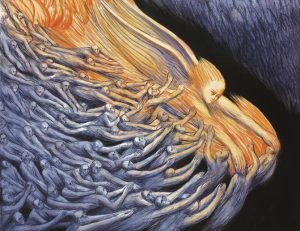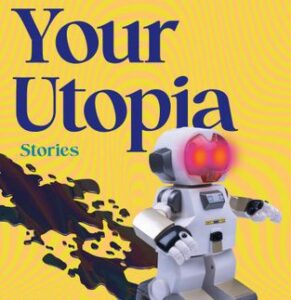Ariel Levy’s The Rules Do Not Apply
In 2012, Ariel Levy, a New Yorker staff writer since 2008 and author of Female Chauvinist Pigs, had it all: a wife, a successful career, and a baby on the way. Five months pregnant, she flew to Mongolia on a reporting trip where her life as she knew it would begin its stunning collapse. Levy’s memoir The Rules Do Not Apply—born in part from her award-winning piece “Thanksgiving in Mongolia” which details her horrific miscarriage on that same trip—is a tightly written account of hubris, devastation, and love.
In Rules, Levy devotes space to her tragedies, but she also writes of her childhood, of her job, and of aging. Luckily, her prose is beautiful and inventive—her ex-partner Lucy “had the radiant decency of a sunflower”; her child’s eyes were “sleeping almonds”—and never seems overwrought. Dealing with universal feelings like fear of motherhood or lust for an old flame, Levy’s sharp perception makes it new.
Though she has suffered profoundly, Levy remains, through no fault of her own, a well-off white woman (albeit a Jewish and queer one). Because of her relative privilege, you can easily make the argument that her twin theses—”life is often terrible” and “having it all is impossible”—stem from an entitled perspective.
But who’s to judge the application of a woman baring her greatest sorrows? It is almost always a gift to read someone’s story, especially when it’s as honest and well-written as Rules. To quote Levy herself, “There’s something of value in trying to put the world into words.”
Amy Guay
Haruki Murakami’s Men Without Women
In his latest collection of short stories Men Without Women, Haruki Murakami stays true to the surrealism and melancholy of his previous works, writing about bugs turned human, women who identify as lamprey eels, and mysterious cats to explore the most realistic human feelings and experiences. Despite having unrelated characters and plot lines, the short stories all share one specific subject—“men without women,” a concept created by Murakami that encompasses heartache, pain, solitude and nostalgia. A feeling rather than a state of being, it seems to be omnipresent and unavoidable, affecting both the young and old, rich and poor, married and single.
As is evident in the phrase itself, Murakami makes the argument that the feeling he is writing about is specific to men. Each story tells a tale of a man in contact with a woman—a girlfriend, a wife, or an acquaintance. In the end, after some level of romantic involvement, they split, always because of a divergence in their experience of the relationship. The stories are invariably tragic, some more explicitly than others—ending in insanity or suicide. But even those that don’t end with death still leave the reader feeling that men and women are inherently different, that even in a happy and passionate marriage, there exists a fundamental misunderstanding of one another.
The tragedies of Men Without Women aren’t just in the loss of a partner; they lie in the terrifying idea that it’s impossible to find a true romantic partner in the first place. The characters may be men, but the loneliness Murakami taps into is universal.
Lizz Pankova
David Grann’s Killers of the Flower Moon: The Osage Murders and the Birth of the FBI
Blood may be thicker than water, but Killers of the Flower Moon suggests that oil trumps both.
Killers of the Flower Moon tells the true story of the Osage Indians, who struck gold when they found oil in the 19th century. The tribe then descended into decadence before being stricken with a series of murders in the 1920s. Killers displays Grann’s ability to craft a narrative with historical fact: he takes central figures in the murders, such as Mollie Burkhart, and fleshes them out using information from historical documents. The result is that the murder victims feel like real human beings, not just dead bodies.
As he showed with The Lost City of Z, Grann is adept at conveying historical fact while still maintaining a gripping narrative. While the murders are the central story of the book, the political machinations of the FBI investigation also play a large role. J. Edgar Hoover features heavily as the book delves into the flaws in the investigations—and the agents behind them.
The book is rife with dark subject matter, so it is easy to become bogged down in various poisonings, shootings, and explosions. But Grann is able to weave complex and confusing narratives together to create a fascinating work. He visits the modern day Osage County in a coda to understand the long-lasting ramifications of the murders, providing the book with a frighteningly contemporary context.
Graham Piro
Pamela Paul’s My Life with BOB: Flawed Heroine Keeps Book of Books, Chaos Ensues
As the editor of the New York Times Book Review, Pamela Paul is more accustomed to critiquing other people’s stories than writing her own. In My Life with BOB: Flawed Heroine Keeps Book of Books, Chaos Ensues, Paul provides readers with a unique view into her personal history through the lens of the Book of Books (BOB), the scrappy notebook where she’s dutifully recorded the date and title of every book she’s ever read.
And while the reader does not gain access to the deeply personal content of the BOB’s pages itself, Paul describes each phase of her life within the context of the books that shaped her view of the world at the time—she assigns each chapter to a relevant book title—as she explores the complex relationship between book and reader.
My Life with BOB serves as both a dynamic love letter to the art of reading and to Paul’s personal development as a reader. She describes the evolution of her desire to read, starting as a child trying to gain exposure to taboo and forbidden topics and continuing on to her time at Brown University, where “a surfeit of criticism swirled around campus, yet [she] still didn’t understand what it meant to critique.”
Post graduation, the BOB follows Paul to Thailand and China, and eventually through several important relationships. Perhaps most notably, Paul uses her relationship with her ex-husband to reflect on the use of books to confirm or challenge our core beliefs.
Armed with a self-deprecating sense of humor and a light tone, Paul’s memoir is both thoughtful and endearing, despite remaining in the admittedly narrow scope of a life where books are readily available and academic privilege is abundant. My Life with BOB is a relatable and well-loved story for book lovers that can act as the beginning of a deeper conversation about how books influence our lives.
Devon O’Dwyer
Emily Fridlund’s History of Wolves
Emily Fridlund’s debut novel, History of Wolves, is a bleak coming-of-age story set in remote, northern Minnesota. Having grown up on a defunct commune with her emotionally distant parents, 14-year-old Linda is isolated, her only friends are the four dogs chained up outside her family’s ramshackle cabin. The book opens with one of Linda’s teachers, Mr. Grierson, getting arrested on child pornography charges, and a new family moving in across the lake.
The novel is undeniably eerie, with long scenes of Linda making her way across the still lake or trekking through the dense woods surrounding her town. As Fridlund skillfully weaves the two opening stories together, the reader knows something is off, even if they can’t quite put their finger on it. By the time the pieces come together in a horrifying climax, it is too late.
History of Wolves deftly subverts typical coming-of-age tropes. By including chapters with an older Linda, still grappling with the guilt of what happened during her fourteenth summer, Fridlund chooses not to give our narrator any dramatic moments of revelation or understanding. If anything, she is left more confused.
Fridlund’s language is precise, drawing out specific metaphors while maintaining a sense of dreaminess. When describing summer, Fridlund writes “You yearn for it and yearn for it, but there’s always something wrong. Everywhere you look, insects thicken the air, birds rifle the trees, enormous, leaves drag the branches down. You want to trammel it, wreck it, smash things down. The afternoons are so fat and long. You want to see if anything you do matters.”
History of Wolves stirs up bigger questions: of aggression, of complicity, of passivity. Ultimately, it gives readers no resolution. No catharsis. Just a slow unravelling of the niceties that hide a greater horror.
Caitlin Mannering
Hope Nicholson’s The Spectacular Sisterhood of Superwoman
The best superheroes are not always the ones we remember.
In The Spectacular Sisterhood of Superwomen: Awesome Female Characters from Comic Book History, Hope Nicholson argues that the best superheroes are often the short-lived, challenging, and unconventional ones forgotten by history.
As the lengthy title suggests, no scraggly-sketched page of comic history goes unexamined. Nicholson intimately and thoughtfully introduces readers to 100 impassioned, smart, strategic, and plucky heroines.
The book sheds light on many obscure comics, such as Kath, Raven, and Angie, which features three gangsters’ wives who take control after their husbands go to jail. The series is beautifully rendered, depicting each woman with a rugged toughness fit for dark crime noir, their vengefulness and backstabbing often foiling their success.
Another overlooked heroine comic, Starlight, aimed to educate white readers about Native American culture. Starlight was both praised for featuring a passionate, powerful, blossoming Indian warrior and criticized for over-generalizing and glamorizing indigenous life. After only seven issues, it faded into the comicstrip abyss.
Nicholson’s book is not really a compilation of the “best” superwomen. Rather, Nicholson promises the “weirdest, coolest, most of-their-time” characters, “for better or for worse.” Most women outlined in the book fall victim to poorly-written non-substantive plots—influenced by gender and racial status quos, and illustrators often drew disproportionate bodies with sexualized ink. At first glance, there isn’t much in superwomen history to proudly rally young girls’ imaginations.
However, the comics outlined in the book are the product of many female writers, illustrators, designers, and characters in a male dominated world. Their bravery, quirkiness, and persistence offers inspiration and motivation to keep fighting—on and off the comic pages. And importantly, Nicholson teaches us that superwomen, since the dawn of the comic age, have exemplified the idea that to be a heroine is to be unapologetically, wholeheartedly one’s own.
Emma Francois
Adam Bradley’s The Poetry of Pop
True to its title, Adam Bradley’s The Poetry of Pop is a systematic breakdown of the poetic artistry behind pop music. Covering a century’s worth of music, Bradley shows a vast range of knowledge, supplemented by citations from musicians and theorists new and old on everything from “Paradise City” to the “Alphabet Song”. Although thorough, his distinctions between poetry and pop put a highly intuitive, self-explanatory concept under the microscope, making the academic validity and necessity of his work questionable.
Bradley, an expert on hip hop and literature, begins his argument with fundamentals arguably too simplistic and repetitive, to the point that his finer criticism is often lost to these broad and easily acceptable concepts. He writes, “Besides being vessels for a song’s emotion, lyrics also function in the act of storytelling.” As a result, Bradley’s sophisticated language and demonstrable expertise are too often spent on finding unneeded explanations.
The author’s own sense of humor fills the book. Bradley is a professor in his respective field, and his wit often reflects this background. Although his subtle pop culture references are pleasurable, his jokes often have an educational goal that his own prose cannot match, leaving lines about “weedheads and teenagers” standing out uncomfortably.
Despite the slow toil of his work, in the end the reader is left with an impressive, comprehensive guide to the culture, musicality, and poetry within pop. Bradley tackles a daunting task: bringing together and comparing two very different artistic mediums. Although he stumbles along the way, there is inherent value in his slow-building argument, leaving readers with a finer appreciation for a genre that is often dismissed.
Mike Bergin





